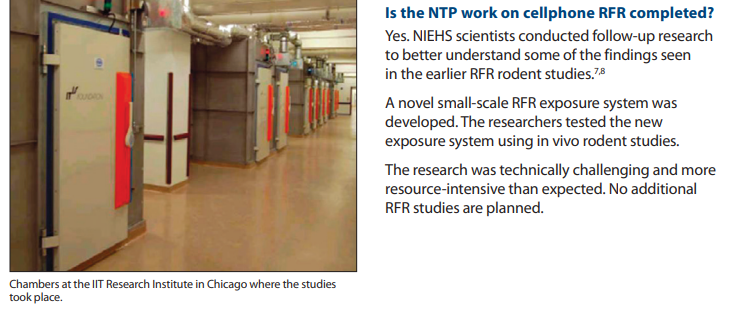
Given the extensive background and developments in research regarding the non-thermal effects of radiofrequency radiation (RFR), the cessation of the National Toxicology Program’s (NTP) RFR studies due to funding redirection to the war in Ukraine marks a pivotal moment in environmental and public health research. Visit the memorial site started by RF Safe’s founder in 2001 here – Libertyunites.tv (Tributes and Vigils) Fact: More people will die when money is diverted from health science research to fund wars. Both short-term and long-term!

This blog seeks to delve into the implications of this decision, the methodology, and findings of the NTP study, the translational relevance of its outcomes, and the critical need to integrate bioelectric science with electromagnetic field (EMF) research.
Methodology and Key Findings of the NTP Study
The NTP study, utilizing rats and mice, aimed to assess the cancer risk and other potential health hazards from exposure to RFR akin to 2G and 3G cell phones. It revealed clear evidence of tumors in male rats’ hearts, some evidence of tumors in brains and adrenal glands, alongside significant DNA damage in certain tissues. These findings challenge the long-held belief that RFR is harmless at non-thermal exposure levels, underscoring the need for a deeper understanding of RFR’s biological effects.
Translational Relevance and Future Directions
Despite challenges in translating animal study results to human health implications due to exposure level and duration differences, morphological similarities between rat tumors and low-grade human gliomas suggest a potential for translational relevance. This highlights the importance of further research to uncover the mechanisms behind RFR’s biological effects, particularly in light of genetic profiling studies that validate these findings.
Integrating Bioelectric Science and EMF Research
The integration of environmental EMF studies with bioelectric science is paramount for progressing our comprehension of EMF’s health impacts. By exploring how environmental EMFs interact with biological systems’ electrical properties, we can potentially uncover new therapeutic approaches and mitigation strategies. The therapeutic potential of non-thermal mechanisms of RF radiation, as demonstrated by FDA-approved treatments like TheraBionic and the Oncomagnetic device, further advocates for this interdisciplinary research approach. These findings challenge the longstanding assumption that RFR is harmless at non-thermal exposure levels.
The Need for a Comprehensive Research Agenda
The halt of the NTP’s RFR research underscores a significant knowledge gap in understanding digital age environmental health risks. It necessitates a comprehensive research agenda that combines bioelectric science with EMF research to develop effective public health protection strategies against RFR exposure. This approach is vital as we continue to advance rapidly in wireless technology.
The discontinuation of the NTP’s RFR research signals a critical need for sustained efforts to grasp the full spectrum of health implications linked to RFR exposure. By fostering collaborative, interdisciplinary research integrating bioelectric science, we can ensure the development of safe RF radiation applications in medicine and daily life while protecting public health in our increasingly wireless world.
The implications of these findings extend far beyond mere statistics. They challenge the very foundation upon which our understanding of EMF safety rests. No longer can we afford to dismiss concerns about EMF exposure as mere speculation or paranoia. The evidence speaks for itself, painting a chilling picture of the unseen dangers lurking in our midst.
As of January 2024, the extensive review of studies on the effects of electromagnetic fields (EMFs) reveals significant findings across various categories of health impact:
Radio Frequency Radiation (RFR):
- Oxidative Effects: 89% of studies found significant effects, highlighting the potential for RFR to induce oxidative stress, even at levels below current safety thresholds.
- Genetic Effects: 70% reported significant effects, including alterations in gene expression, suggesting a risk to genetic integrity from RFR exposure.
- Neurological Effects: 77% of studies observed significant impacts, raising concerns about the potential for RFR to affect neurological health and function.
- Reproductive Effects: 83% found effects on reproduction and development, indicating potential risks to fertility and developmental health.
Extremely Low Frequency (ELF) and Static EMFs:
- Oxidative Effects: 91% of studies reported significant effects, indicating a strong potential for ELF/static EMFs to cause oxidative damage.
- Genetic Effects: 84% showed significant effects, including a high incidence of gene expression changes, suggesting potential genetic risks.
- Neurological Effects: 91% observed significant neurological impacts, underscoring the potential for ELF/static EMFs to affect brain health and function.
- Reproductive Effects: 75% reported significant findings, highlighting concerns over the impact of ELF/static EMFs on reproductive health.
These findings call for a critical reevaluation of current exposure guidelines and further research to fully understand the health implications of EMF exposure.
As we stand on the precipice of an increasingly wireless world, the need for awareness and action has never been more urgent. The time has come to confront the uncomfortable truth about the risks posed by electromagnetic fields. Ignoring these warnings would be a grave disservice to public health and well-being. It’s time to shine a light on the invisible danger and take decisive steps to protect ourselves and future generations from its insidious effects through understanding the effects of EMFs on bioelectricity.
Ready For The Research? Ready For The Truth?
The scientific community will burn you at the stake like Burno for knowing the truth that threatens the Status Quo about non-thermal RFR exposure risk!
I don’t know what is wrong with the scientific community!! How many studies did they need to change opinions about Earth being the center of the universe? I used to wonder how someone could be burned to death for observing and speaking the scientific truth! Why are the scientific experts obviously on the wrong side of scientific truth so hell-bent on killing people just to hold on to a belief that can NEVER be supported by science!
Non-thermal radiation will never be proven biologically inert, just as no study can be produced to prove the earth is the center of the universe or flat. You are just killing people to hold onto your beloved outdated scientific beliefs! The only difference is instead of burning Bruno at the stake, scientists are burning our children’s bioelectric blueprint while in their homes, at school and when sleeping with unnatural non-thermal microwave radiation exposure because they are too proud and too controlled to speak the truth!
This collection of EMF studies contains about 2,500 research papers. The abstracts for these studies can be downloaded by clicking on the links below.
The document titled “The Effects of Radiofrequency Radiation Exposure on Oxidative Cellular Processes“ provides a comprehensive overview of the research conducted on the impact of radiofrequency radiation (RFR) on oxidative stress in cellular systems. It highlights that out of 354 studies published between 1997 and January 2024, a significant majority (89%) reported notable effects of RFR exposure, indicating changes in cellular free radical status even at low specific absorption rates. The findings demonstrate that RFR influences oxidative processes across a variety of frequencies, exposure durations, and biological systems, supporting the conclusion that radiofrequency radiation affects cellular redox status. The document emphasizes the predominance of in vivo studies involving long-term exposure scenarios, which are particularly relevant for understanding real-life impacts. Moreover, it suggests that modulation of RFR, such as waveform variations in wireless communication, may have significant biological effects, underscoring the complexity of studying and simulating real-life exposure to RFR.
The document “Genetic Effects of Radiofrequency Radiation(RFR)” presents a detailed investigation into the impacts of RFR on genetic material, encompassing a wide spectrum of studies. It reveals that a significant portion of research indicates observable genetic effects from RFR exposure, with 70% of publications reporting effects and 30% reporting no effects. Specifically, gene expression studies show a higher incidence of effects, with 79% indicating changes. This comprehensive analysis underscores the complexity and variability of RFR’s impact on genetic integrity, highlighting the need for continued research in this critical area of public health and safety.
The document “Neurological Effects of Radiofrequency Radiation(2007-2023)“ provides a thorough examination of the impact of radiofrequency radiation (RFR) on neurological functions, based on studies conducted between 2007 and 2023. It highlights the significant concern regarding potential hazardous health effects of RFR exposure from mobile phone use and other sources on the human nervous system. The compilation includes a mix of findings with some studies indicating potential neuropsychiatric problems and changes in neurobehavioral functions among exposed populations, while others show no significant effects or even potential cognitive benefits. This document underscores the complexity of RFR’s impact on neurological health, suggesting the need for further research to fully understand its implications and to develop guidelines for safe exposure levels.
The document “Effects of Radiofrequency Radiation Exposure on Reproduction and Development“ explores the impact of radiofrequency radiation (RFR) from mobile phones and other wireless devices on reproductive health and development. It examines a range of studies focusing on the effects of RFR exposure on both male and female reproductive systems, embryonic development, and potential consequences for offspring. The findings suggest that RFR exposure may have detrimental effects on fertility, including changes in sperm quality and potential impacts on embryo development. The report emphasizes the need for further research to fully understand these effects and suggests potential mechanisms through which RFR exposure might affect reproductive health.
The document “Static and ELF EMF Oxidative Effects“ presents a comprehensive analysis of the effects of Extremely Low Frequency Electromagnetic Fields (ELF EMF) on oxidative stress mechanisms. It summarizes findings from various studies, showing a significant majority reporting oxidative effects induced by ELF EMF exposure. The document highlights the impact on oxidative damage, free radical production, and antioxidant activity across different biological systems. This synthesis underscores the potential health risks associated with ELF EMF exposure, particularly concerning oxidative stress, which is linked to various diseases and cellular damage. It emphasizes the need for further research to understand the mechanisms behind these effects and to assess the potential long-term health implications.
The document “Static and Extremely Low Frequency (ELF) EMF Genetic Effects“ provides a critical analysis of the genetic impact of exposure to static and ELF electromagnetic fields (EMF). It synthesizes research findings, showing that a substantial majority of studies report genetic alterations following ELF EMF exposure. Specifically, 84% of the reviewed studies observed genetic effects, with gene expression studies showing an even higher impact rate of 95%. This document underscores the significant potential for ELF EMF to induce genetic damage, raising critical considerations for public health and safety due to the widespread presence of ELF EMF in the environment.
The document titled “Static and Extremely Low-Frequency (ELF) Electromagnetic Field (EMF) Neurological Effects“ presents an extensive overview of research conducted on the neurological effects of ELF EMF exposure from 2007 to 2023. The findings illustrate a significant observation of effects in 91% of studies, showcasing the profound impact ELF EMF can have on neurological functions. This comprehensive review underscores the potential risks associated with ELF EMF exposure, highlighting the need for further investigation into its effects on the nervous system, and suggests a reevaluation of exposure guidelines to ensure public health safety.
The document titled “Genetic Effects of Static and Extremely Low Frequency (ELF) Electromagnetic Fields“ provides an in-depth analysis of the genetic impact of ELF electromagnetic fields on various biological systems. It compiles a broad range of studies, showing that a significant proportion (84%) reported genetic effects, including DNA damage and changes in gene expression, from exposure to these fields. Particularly striking are the gene expression studies, where 95% reported effects. This compilation underscores the potential genetic risks associated with ELF EMF exposure, urging further investigation into its implications for health and safety.
The document “Static and ELF EMF Genetic Effects“ provides an in-depth analysis of the genetic impacts of static and Extremely Low Frequency Electromagnetic Fields (ELF EMF). It covers a wide range of studies, revealing that a significant majority (84%) of the studies reported genetic effects resulting from ELF EMF exposure. Specifically, gene expression studies show an even higher rate of effects, with 95% indicating changes. This comprehensive review underscores the potential risks associated with ELF EMF exposure, highlighting the need for further investigation into its genetic implications and suggesting a significant concern for public health and safety.
The document titled “Intermediate Frequency Studies by Henry Lai“ is a comprehensive review of research into the effects of intermediate frequency electromagnetic fields (IF-EMFs) on biological systems. It details various studies investigating the potential health impacts of IF-EMFs, which fall between the low frequency and radiofrequency ranges. This review highlights studies on a wide array of biological outcomes, including cellular, genetic, and neurological effects, as well as potential implications for human health. The document emphasizes the need for further research in this area, given the increasing exposure to IF-EMFs from modern technology and the relatively limited understanding of their health effects.
Intermediate Frequency Electromagnetic Fields (IF-EMFs) refer to electromagnetic fields with frequencies ranging from 300 Hz to 10 MHz. This range lies between Extremely Low Frequency (ELF) fields and Radio Frequency (RF) fields, encompassing frequencies used in various electronic devices and industrial applications. IF-EMFs are of interest in research and public health discussions due to the increasing exposure from technologies like computer monitors, induction heaters, and security systems, and the need to understand their potential biological effects and health implications.








